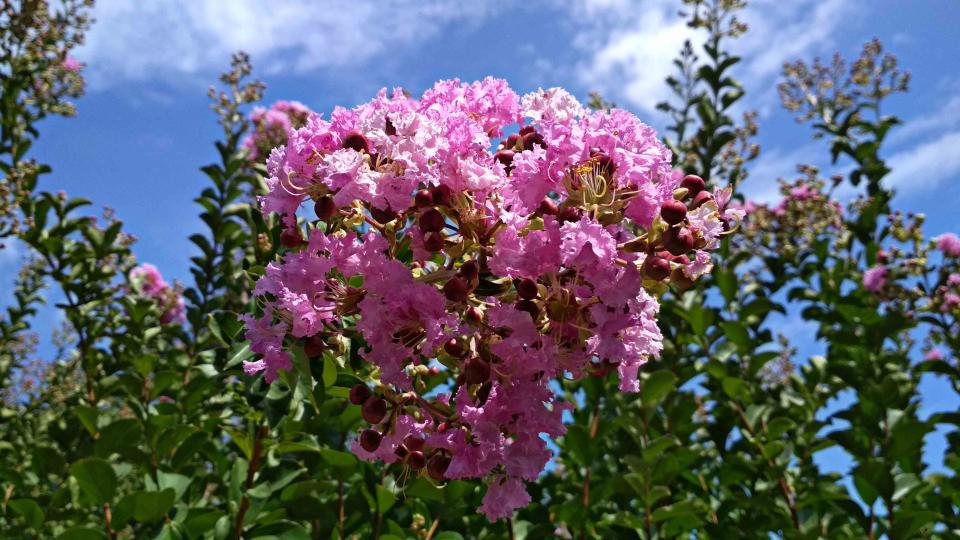Dwarf And Semi-Dwarf Crepe Myrtle Trees We Love
Crepe myrtles are a go-to flowering tree for Southern gardens, but not every garden is suited for a large tree. These dwarf varieties are great to mix into perennial beds, to grow in planters, or to use as deciduous hedgerows.

Getty Images
Why do people murder crepe myrtles? No, it's not too much Neanderthal DNA. It's that the variety of crepe myrtle they planted got way too big for their space. Thankfully gardeners and growers both saw the need for smaller, more compact crepe myrtles—or crape myrtles or crapemyrtles if you prefer—that didn't need annual pruning. Growers created new selections of dwarf and semi-dwarf types that bloomed well, resisted disease, and were hardy. Let me introduce some of my favorites, all of which are available at garden centers.
Dwarf Crepe Myrtle Varieties
Dwarf myrtles include cultivars that are less than 4 feet tall when fully grown. These smaller crepes give all the brilliant color of their taller cousins, but because they’re smaller, you can get a little more creative and have some fun with them.
You can plant just one as an accent shrub, or group several of them for a big show of color. If you really want to stop traffic, combine them with complementary plants for a low-maintenance border with "wow" factor. For example, a tall evergreen shrub such as 'Burgundy' Chinese fringe (Loropetalum chinense) makes a nice backdrop for the cherry red, pink, or white blooms of a dwarf crepe myrtle. Then for the foreground, you can add a low-growing evergreen such as blue rug creeping juniper. The possibilities with these bitty bloomers are endless.
'Pocomoke'
This pretty dwarf myrtle features bright-pink blooms and deep green foliage on a mounding shrub. It’s a great pick for pots.
Size: 3 to 5 feet high, 3 to 4 feet wide
Zones: 6-9
Razzle Dazzle Series
These mounding shrubs come in a wide range of colors that do great in containers. I recommend 'Cherry Dazzle' (red blooms), 'Berry Dazzle' (fuchsia-purple blooms and burgundy new foliage), and 'Strawberry Dazzle' (neon-rose flowers). I’ve found that 'Raspberry Dazzle' doesn't bloom as well.
Size: 3 to 4 feet tall and wide
Zones: 6-9
'Tightwad Red'
Dark-red flowers on a mounding plant. Seedless. Dense foliage
Size: 3-4 feet tall and 5-6 feet wide
Zones: 7-10
'Victor'
Deep-red flowers. Cold-hardy.
Size: 3-6 feet tall and 2-4 wide
Zones: 6-9
Semi-Dwarf Crepe Myrtle Varieties
If you’re looking for something a bit larger than a dwarf myrtle but still don’t want a big variety, consider a semi-dwarf variety. Semi-dwarf or small crepe myrtles typically top out at 12 feet tall or less at maturity. Anything else we can say here about trees of this size?
'Acoma'
That's it up top. White flowers atop an arching, sculptural small tree. Great in a large container.
Size: 10 feet tall and wide
Zones: 6-9
'Delta Jazz'
Combines bright-pink flowers with spectacular burgundy foliage that doesn't "green" in hot weather.
Size: 8-10 feet′ high and 4-6 feet wide
Zones: 7-10
Part of our Southern Living Plant Collection.
Early Bird Series
Comes in three colors—lavender, purple, and white. Long-blooming plant starts flowering in May. Grows 5 to 8 feet tall.
Size: 5-8 feet High and 3-4 feet Wide
Zones: 7a - 10b
Part of our Southern Living Plant Collection.
'Hopi'
Medium-pink flowers on a spreading, bushy plant.
Size: 7 to 10 feet tall and wide
Zones: 6-9
Magic Series
Rounded, bushy plants. Colors include coral-pink, fuchsia-pink, and purple. Foliage emerges reddish and then changes to deep-green.
Size: 6 to 10 feet tall and 4 to 8 feet wide
Zones: 7-9
'Pink Velour'
Neon-pink flowers with wine red foliage that doesn't fade. Nearly seedless; blooms for a long time.
Size: 6-12 feet tall and wide
Zones: 6-9
'Red Rooster'
Brilliant red flowers. Foliage emerges maroon and changes to green. Flowers may show white or red flecking.
Size: 8 to 10 feet tall and 5 feet wide
Zones: 6b-9
'Rhapsody in Pink'
Combines soft-pink flowers with purplish new growth. Nearly seedless; blooms for a long time.
Size: Upright grower 6 to 10 feet tall and 8 to 12 feet wide
Zones: 6-9
'Siren Red'
Dark-red flowers on a rounded plant. New foliage emerges wine-red and then changes to dark green.
Size: 6 to 10 feet tall and wide
Zones: 6-9
'Tonto'
Red flowers and maroon foliage. Handsome bark.
Size: 8 to 12 feet tall and wide
Zones: 6-9
'Velma's Royal Delight'
Intense purple-magenta flowers and deep green leaves. Cold-hardy to well below zero degrees. Bushy plant growth.
Size: 4 to 6 feet tall and wide
Zones: 6-9
'Zuni'
Medium-lavender flowers on a vase-shaped, spreading plant. Long bloomer, cold-hardy, handsome bark.
Size: 6 to 10 feet tall and wide
Zones: 6-10
Frequently Asked Questions
Where is the best place to plant a dwarf crepe myrtle?
Dwarf crepe myrtles grow best in full sun and well-drained, loamy, or clay soils. In areas with less sun exposure, crepe myrtles produce fewer flowers and are susceptible to diseases. Proper air circulation and healthy soil help prevent diseases from developing.
What time of year is best to plant crepe myrtles?
Plant crepe myrtle trees when the soil is warm, but not in the summer, as it is drought-tolerant once established but should not experience hot and dry spells until then. Early spring or late fall is best for planting crepe myrtles.
For more Southern Living news, make sure to sign up for our newsletter!
Read the original article on Southern Living.

